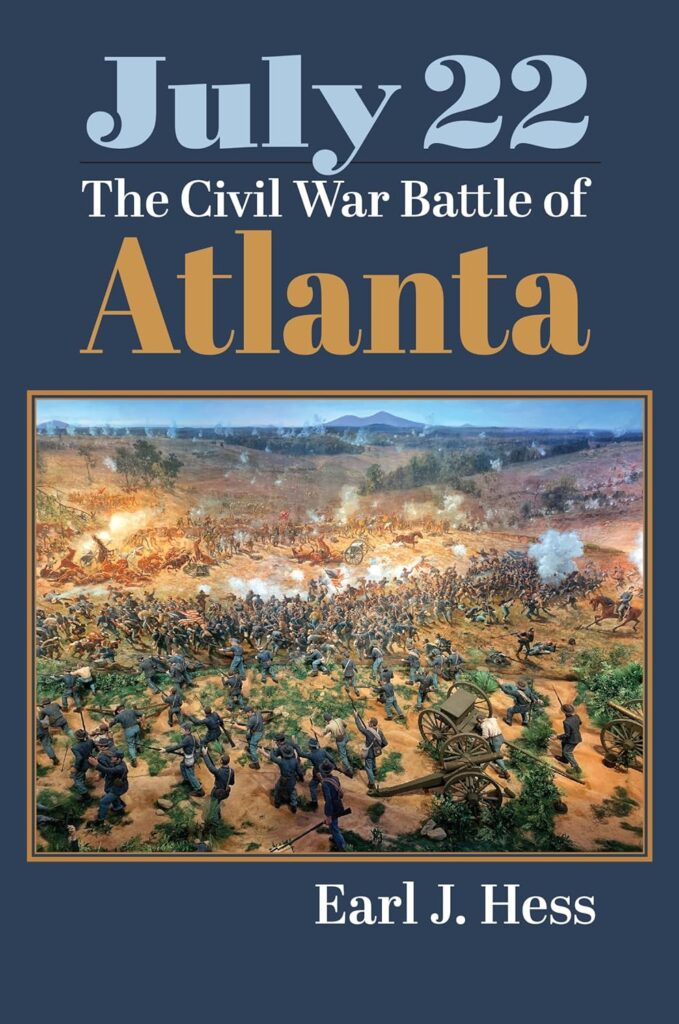By Earl Hess.
Lawrence: University Press of Kansas, 2023.
ISBN 070-0-63396-0. Illustrations. Maps. Notes. Bibliography. Index.
Pp. 432. $44.99.
This excellent book by one of the finest Civil War historians examines the events that led up to the Battle of Atlanta. Earl J. Hess proposes new contentions regarding the battle of 22 July 1864 for the greater Atlanta Campaign and the total Federal fighting effort to take the strategic city. Hess has penned three other excellent studies on this campaign: Kennesaw Mountain: Sherman, Johnston, and the Atlanta Campaign; The Battle of Peach Tree Creek: Hood’s First Efforts to Save Atlanta; and The Battle of Ezra Church and the Struggle for Atlanta. Additionally, he wrote a very helpful field fortification and operational history of the entire Atlanta Campaign: Fighting for Atlanta: Tactics, Terrain, and Trenches in the Civil War. In this latest book on the campaign for Atlanta, Hess provides readers with richly researched material and analysis on the series of skirmishes and battles around Atlanta, especially on Bald Hill.
In the brutal battle fought east of Atlanta on 22 July 1864, the Union Army of the Tennessee once again demonstrated its effectiveness in combat. The circumstances of the contested battle were that Lieutenant General John Bell Hood (CSA) had recently replaced General Joseph E. Johnston as commander of the Army of Tennessee, with a mandate for a more aggressive response to Major General James B. McPherson’s Army of the Tennessee at Bald Hill. The Iowan troops in the Army of the Tennessee were shocked by the Confederates early in the battle, similar to what occurred to Union troops at Shiloh on 6 April 1862. However, Hood and the Confederates’ hope for a victory against the larger Union army group led by Major General William T. Sherman failed to materialize. In the end, Bald Hill was held by the Federals, which saved Sherman’s left flank.
Hess makes a strong argument that a Confederate victory by Hood’s troops on 22 July would not have prevented the eventual fall of Atlanta, nor prevented U.S. President Abraham Lincoln from being re-elected in November 1864. He strongly disagrees with many historians on this point, especially Gary Ecelbarger. Ultimately, Hess details that Sherman was successful in capturing Atlanta. Additionally, Hess asserts that students can gain much from studying this battle’s tactics and combat leadership. Finally, he emphasizes that 22 July was the “…greatest day of fighting by the Union Army of the Tennessee and one of the great days of battle by the Confederate Army of Tennessee.” In the end, Hess concludes that the Union efforts helped save Sherman’s campaign, and Hood’s fighters failed to earn a victory or significantly damage the Union’s effort to take Atlanta.
The deaths of McPherson and Confederate Major General William Walker are examined. Both were popular with their fellow officers and enlisted men. Many Confederate soldiers falsely told their comrades that they fired the shot that killed James McPherson, but Hess pinpoints the most likely candidate and discusses stolen items returned to McPherson’s friends. Hess does a nice job explaining the location where Walker fell. Additionally, he provides excellent anecdotes of both men’s stories in life and death.
In this marvelously detailed study of that battle, Earl Hess makes yet another valuable contribution to scholarship on the struggle for Atlanta, the commanders who shaped its course, and Civil War military history in general. In addition to providing plenty to satisfy enthusiasts of traditional “drums and trumpets” military history, Hess offers intriguing discussions of such topics as other authors comparisons of the subject, McPherson’s death and myths, breaking XV Corps’ line, aftermath of the battles, battlefield commemoration, memory, care of the wounded, disposal of prisoners, burial of the dead, and order of battle. Hess provides readers with significant archival resources he utilized as well as unpublished materials on the battle, which help make this work a must for students of the battle/campaign of Atlanta and the Western Theater. Significant to understanding this battle are twenty-seven fabulous maps and twenty-one illustrations. This great book on the Atlanta Campaign is highly recommended.
David Marshall
Miami, Florida
